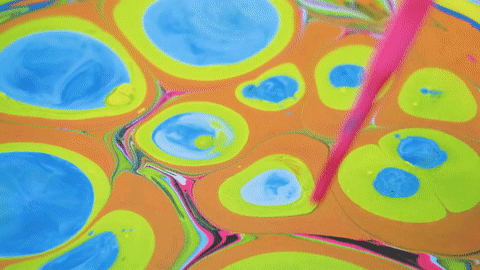Marbling Paints: A Timeless Trend
May 25, 2021Can you believe the marbling technique dates back to the twelfth century? Back then, the Japanese technique was originally termed suminagashi, meaning “ink floating”. It was created by chance, from submerging old ink paintings into water. The ink would separate from the paper and float to the water’s surface, enabling the artist to transfer the image to another piece of paper or parchment (as pictured). The technique would eventually evolve to a form of painting on water that was carried on by many generations and used all over the world. Today’s marbling paints and techniques remain pretty much unchanged but are offered in a wider variety of pigments and media, and amazing results can be achieved in much simpler steps!
Marbling Made Easy by Pebeo

Pebeo’s marbling paints allow you to easily create stunning marbling projects in the comfort of your own home, on any porous surface you fancy. This includes paper, fabrics and wood. Keep in mind – Creative medias with a non-porous surface such as metal or stone can also yield surprising effects! However, you will need to experiment with rugged textures, as some non-porous surfaces might be too slick for the paint to properly adhere to them.
The Pebeo marbling paints pair with Pebeo’s marbling bath for an easier process. It acts as a thickening agent for the water that creates a tension surface where the paints can spread before being worked into your marbling piece. The paints themselves resemble inks; they are very thin and spread easily but are completely water-based and can be used indoors without any issues. The current Pebeo Marbling range includes nine basic colors that can be mixed together to create a wide variety of hues and shades. With those paints, the process itself is made super fun and kid-friendly. It does not require much prep and is the perfect pick-me-up project on rainy Saturday when you need to keep yourself and/or the kids entertained. If desired, you can re-use the marbling bath many times once it is prepared – so get ready for quite the marbling party! You could end up marbling anything from canvas shoes to that boring notepad tucked away in a drawer.

More About Marbling
Pebeo Senior Product Specialist Tristina Dietz Elmes has been having blast with marbling recently, as she prepares for her live virtual demo with OPUS on June 10th. Being both an artist and an astounding teacher, it is SO fitting to have her share her tips and tricks to mastering the marbling technique using Pebeo paints! In the meantime, here is a little sneak peak into Tristina’s experience with marbling:
“As an experimental abstract artist and lover of serendipity, I really enjoy creating with Pebeo’s marbling paints. They have simplified the painting process so that in a short time after preparing the Pebeo marbling bath, I am able to pull bold monoprint color patterns onto my favorite rice and other natural fiber papers, as well as create stunning fabric designs. From the simple ‘stone’ to more complex nonpareil variations, I find these paints hold my combed patterns well for nice crisp results. And, pulling ghost or kitchen-sink prints is always a fun way to use left-over marbling paints for beautiful unexpected outcomes. Since I often incorporate collage and texture into my artworks, it’s very satisfying to grab a stack of dried Pebeo paint marbled pieces and make a unique selection to kickstart my creative process.”
From traditional marbled paper book coverings to home decor, and fashion accessories to fine art, the variety of ways to use Pebeo’s marbling paints is extensive, and one try at it can spark many creative ideas. We encourage you to get inspired by marbling’s rich history, Tristina’s teachings and to simply just explore! Imagination knows no limits.
Explore Pébéo Marbling Colours & Kit

